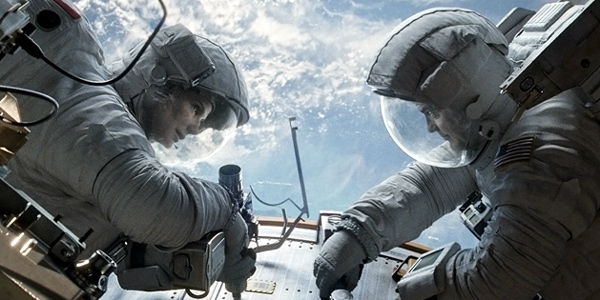
The Moviola Review: Gravity
Written by: B.D. Hall, Special to CC2K
With the Academy Awards nominations recently announced, here’s another look at B.D. Hall’s review of Alfonso Cuarón’s masterpiece Gravity.
At this point, if you don’t rush out to see an Alfonso Cuarón film like a pack of lions at an all you can eat antelope buffet, you’re doing it wrong. The director of Y Tu Mamá También, Harry Potter and the Prisoner of Azkaban (the undisputed best of the series), and the outright masterpiece, Children of Men, is film by film pulling his chair up to the Greatest of All Time table. On a site like this that deals heavily with all things “greatest” in the world of cinematic history, I’m well aware that such a statement could get me skewered. Furthermore, given his age – 51 – and his slow trickle of production – this is his first feature in 7 years – I’m also aware that he may never reach that table. But, like, whatever man. I will argue ‘til I’m out of breath that Children of Men is one of the most impressive films since the invention of the steadicam – a technical and emotional jaw-dropper that feels so ignored by so many that I’m starting to worry those Crazy Pills™ I’ve been taking might be more than placebos.
While Gravity is not that, it is, nonetheless, a 90 minute heart attack that comes just short of its predecessor. And though I have never been an advocate of the 3D “craze” – to me, it’s always seemed like gimmicky schlock a la Smell-O-Vision and Rumble Seats – I would be remiss if I didn’t strongly urge you to don some tinted 3D specs and see this film in the theater the way Cuarón and his longtime cinematographer, Emmanuel Lubezki, meant for you to see it. The experience is breathtaking. Literally; the awe-inspiring visuals and consistently terrifying plot left me struggling for breath so regularly that I could only watch as Sandra Bullock’s character was running out of oxygen in her space suit and think, “I feel ya, girl.” Talk about an immersive moving-going experience. Take that, Smell-O-Vision!
In classic Cuarón style, Gravity opens with a 20-minute single shot that floats within and throughout space at times orbiting or being orbited by a space station somewhere near the Hubble telescope in between Earth and Holy Shit. As we lose all sense of polarity, we’re introduced to a nonchalant, jet-pack wielding, veteran space cowboy, Matt Kowalski played by George Clooney as George Clooney, who teases, gently and flirtatiously, engineer Ryan Stone (Bullock), queasy on her first space mission. Of course, as one would expect, the Russians have blown up their own satellite (by accident?) which has set off a chain reaction of exploding satellites and deadly debris whizzing around the Earth and heading right for our heroes. We learn this little bit of terrifying information from the mission control bound, disembodied voice of Ed Harris, affirming filmmaking rule 314 Section B: All films set in space must feature Ed Harris. Check and check, Cuarón.

As our astronauts hurry to get back to safety, Stone becomes untethered and careens off into space. There ends my plot summary as the ensuing 70 minutes are a master lesson in keeping the audience equally untethered. (Suck it, Rumble Seats.) Twists and turns abound and pile up, but they’re made all the more spectacular by the often CGI’d space choreography and discombobulating cinematography. In Cuarón’s last film, the long, single-take camera shots featured a bevy of tricks, not the least cool of which were those that managed to float seamlessly into and out of cars in the midst of chase scenes. Here, in stunts equally cool, we frequently shift from an objective perspective, usually of a body tumbling inexorably away into the Holy Shit, to a first person view; from outside the space helmet to inside, where we watch the earth rapidly rise and set through our field of vision, over and over again, with no end in sight.
Furthermore, and this must be a testament to the weightlessness of the setting as well as the 3D, but there is one moment in particular, a long shot of Stone working outside of her craft, where chaos erupts silently in the background and quickly races to the foreground overwhelming both her and us. It is a remarkable bit of terror-inducing filmmaking that would please even Hitchcock. Of course, in between heart attacks, thanks to the debris from Hell swinging round the Earth in 90 minute intervals, Cuarón and Lubezki slow the universe down to appropriate levels of solipsistic meditation, an opportunity not just to catch our breath and examine the awesome and beautiful nothingness outside our atmosphere, the meaninglessness of our existence, but also to remind ourselves that being an astronaut is stupid. Really stupid.
Unlike Children of Men, Gravity doesn’t carry the same emotional heft, and that’s due to so much weight being placed on a single traumatic event in Ryan Stone’s past. It feels a touch cloying, especially considering it isn’t needed. The film is executed so brilliantly, the stakes so clear and understandable – Earth vs. Holy Shit – that overcoming the terrestrial trauma feels, at the moment, a touch irrelevant, nor does the triumph over her past feel wholly justified or earned. In the end, it feels like it was put there to pull heart strings, but I’m picking nits and didn’t give a flying whoop about that while in the theater. My girlfriend has bruises on her knee from the 90 minute death grip I put on it. You have to go see this movie. It’s the best movie about Holy Shit since 2001: A Space Odyssey and it’s by Alfonso Cuarón so you know it’s good.
Originally published at The Moviola
